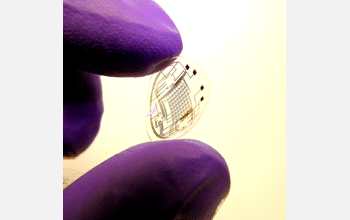Multimedia Gallery
Contact Lenses With Circuits (Image 3)
Contact Lenses With Circuits (Image 3)
A researcher holds one of the completed lenses developed by engineers at the University of Washington (UW).
The lenses were developed by a team of engineers, led by Babak Parviz, an assistant professor of electrical engineering at UW, who used manufacturing techniques at microscopic scales to combine a flexible, biologically safe contact lens with an imprinted electronic circuit and lights. The lenses were tested on rabbits for up to 20 minutes and the animals showed no adverse effects.
A virtual display like this could be used by drivers or pilots to see a vehicle's speed projected onto the windshield; by video-game companies who could use the contact lenses to completely immerse players in a virtual world without restricting their range of motion; or, in the field of communications, by people on the go who could surf the Internet on a midair virtual display screen that only they would be able to see.
The prototype device contains an electric circuit as well as red light-emitting diodes for a display, though it does not yet light up. The researchers built the circuits from layers of metal only a few nanometers thick, about one thousandth the width of a human hair, and constructed light-emitting diodes one third of a millimeter across.
The research was funded by a Technology Gap Innovation Fund from the University of Washington, and by the National Science Foundation's Faculty Early Career Development (CAREER) Award, through the Engineering Directorate's Division of Electrical, Communications and Cyber Systems Division (ECC 06-44084, "CAREER: Self-Assembly of Functional Systems Within Live Cells"). To read more about this research, see UW news release "Contact lenses with circuits, lights a possible platform for superhuman vision." (Date of Image: 2007) [Image 3 of 3 related images. Back to Image 1.]
Credit: Babak Parviz, University of Washington
Images and other media in the National Science Foundation Multimedia Gallery are available for use in print and electronic material by NSF employees, members of the media, university staff, teachers and the general public. All media in the gallery are intended for personal, educational and nonprofit/non-commercial use only.
Images credited to the National Science Foundation, a federal agency, are in the public domain. The images were created by employees of the United States Government as part of their official duties or prepared by contractors as "works for hire" for NSF. You may freely use NSF-credited images and, at your discretion, credit NSF with a "Courtesy: National Science Foundation" notation.
Additional information about general usage can be found in Conditions.
Also Available:
Download the high-resolution JPG version of the image. (1.5 MB)
Use your mouse to right-click (Mac users may need to Ctrl-click) the link above and choose the option that will save the file or target to your computer.

